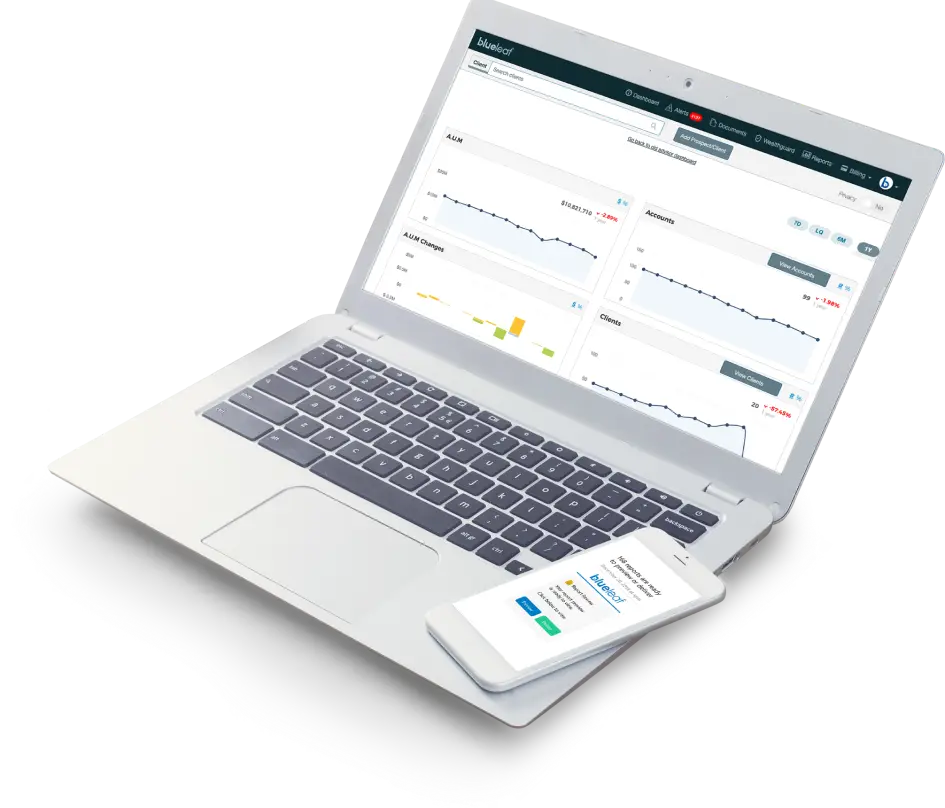Last Updated on April 13, 2023 by John Prendergast
The Pandemic accelerated digital change
The pandemic shook the world in unprecedented ways, impacting global economies and altering the way businesses operate. It also changed clients’ lives and preferences in permanent ways. Clients are much more digital and have much higher expectations compared to pre-pandemic. However, most advisory firms are still catching up, with client portals and mobile apps that don’t engage. The scale and speed of these changes and the challenge of meeting them have made client engagement such a hot topic now. Here are some of the changes we’ve seen:
Dramatically increased online usage
The COVID-19 pandemic forced many people to change their daily routines and adapt to new ways of living. Clients over 65 have been particularly transformed. With social distancing measures in place and limited social interactions, older adults adapted their family, social and business activities to the Internet.
During the pandemic, many older adults turned to social media to stay in touch with their families and friends. With limited in-person interactions, platforms such as Facebook and Instagram became a lifeline for many, allowing them to stay connected with their loved ones and share updates about their lives. Video conferencing tools such as Zoom and Facetime went from novelties to daily staples for older adults who wanted to participate in virtual family gatherings and events.
The pandemic also led to an increase in the use of online banking services among older adults. With many physical bank branches closed or operating at reduced hours, online banking became a more convenient and safer option for managing finances. Many who were previously hesitant to use online banking platforms embraced them as a way to check their account balances, pay bills, and transfer funds. In fact, in a 2022 Harris Poll run by Fiserve, 72% of US banking consumers 70 and older said they use online banking an average of over 7x per month. That is up 100% from a similar survey in 2018.

Increased preference for online meetings
The growing popularity of the internet among older adults has also influenced their preferences for online meetings. Most clients embraced the convenience and accessibility of online meetings during the pandemic. For older adults, online meetings offer a number of advantages. First, they offer flexibility and convenience, eliminating the need for travel. This can be particularly beneficial for those with mobility issues or with summer and winter homes or second homes in remote areas.
A parallel change in healthcare further cemented this preference. As healthcare providers had to go digital during the pandemic, older adults’ most trusted relationship went online, enabling them to attend appointments, receive medical advice, and discuss health concerns without leaving their homes. Telemedicine’s popularity had the spillover effect of making older adults feel more comfortable having important conversations digitally.
Increased financial uncertainty made frequent engagement more important
The uncertainty brought about by the pandemic which continues today left many clients feeling vulnerable and uncertain. Engaging with clients during these challenging times became critical to reassure them that you, their advisor, were working diligently to protect their interests and adapt their strategies to the changing market conditions. That volatility and uncertainty is likely to continue and will continue to demand more frequent engagement.
3 other key trends cemented client expectations
The “tech-savvy grandparent” demographic has been growing
Let’s dispel the myth about older clients not being interested in using technology. According to The Legacy Project, the average age to become a grandparent today is fifty years old. This year, that translates into a date of birth sometime in 1973. Those folks were 80s teens, 90s young adults, and thirty-year-old Facebook users. That may also sound like you.
Over the past few years, there has been a significant increase in the number of older adults using social media platforms. A Statista report released in 2021 showed that 50% of seniors (65+) surveyed have Facebook accounts.
One of the reasons for this trend is the rise of smartphones and tablet technologies among older adults. Many of them, my mom included simply are more comfortable with handheld technologies compared with computers. The pandemic accelerated this and they are now extensive users of this technology. AARP Research in 2023 showed that 86% of those over 50 have a smartphone. And they use them. 94% text, 88% email, and 74% are on social media.

The rise of holistic planning has also driven digital demand
The increasing desire for holistic financial planning has also driven clients to want better digital experiences. Financial planning is no longer just about managing investments or providing basic financial advice, but rather a comprehensive approach that takes into account a client’s entire financial situation, including retirement planning, tax planning, estate planning, and more.
To provide this level of comprehensive planning, advisors need to have access to a wide range of financial data and information. Digital platforms provide advisors with tools that allow clients to connect and pull in held-away assets. With information automatically connected and updated, advisors can provide more personalized and comprehensive financial advice and a higher level of service with less manual work.
Additionally, clients who seek holistic financial planning are also increasingly looking for a more immersive and interactive experience that goes beyond traditional face-to-face meetings. Digital tools such as online dashboards, mobile apps, and financial planning software provide clients with a more holistic digital experience to match the more holistic services of their advisor. Clients now expect that they can monitor their investments and track their progress toward their financial goals on the go.
The digital bar was raised everywhere else
The rise of great digital experiences in other domains has also led financial advisory clients to expect more. Clients have become accustomed to seamless and user-friendly digital experiences in other areas of their lives, such as shopping, entertainment, and healthcare. As a result, they expect the same level of convenience and ease of use when it comes to managing their finances.
Online shopping in particular has reshaped expectations. During the pandemic, older adults turned in droves to E-commerce platforms such as Amazon which has set a high standard for user experience, with personalized product recommendations, one-click ordering, and fast delivery. Clients have come to expect a similar level of convenience and personalization when it comes to managing their wealth.
Healthcare elevated the trust and connection possible online. Telemedicine and digital health platforms have made it easier for patients to access medical care and manage their health conditions remotely. Connecting with a healthcare provider can be one of the most vulnerable exchanges we have. Moving that interaction online made many older adults comfortable opening up remotely and that changed expectation now extends to financial advisors.

Slow adoption has left advisors playing catch up
The slow adoption of client-facing digital tools by advisors has left them behind in meeting the changing preferences and expectations of clients. Older clients, in particular, have come to appreciate the convenience and ease of use of digital tools. Many grandparents have increased their use of the internet, social media, and online banking during the pandemic, as these tools have become important for staying connected with family and managing their finances. Advisors who fail to offer modern digital solutions risk losing clients to competitors who provide a more user-friendly experience.
The fear that digital tools may detract from the personal touch of traditional advisory services is increasingly being dispelled. In fact, digital tools can enhance the client experience and provide a seamless, integrated service that combines the best of both worlds. Advisors who are slow to adopt these tools may not only lose clients but also limit their own efficiency and effectiveness in managing client relationships.
Conclusion
The pandemic accelerated digital transformation and changed the way financial advisors engage with their clients. The increase in online usage among older adults and the growing popularity of online meetings and telemedicine have influenced client preferences for digital experiences. Furthermore, the rise of holistic planning and the high standards set by other industries for user-friendly digital experiences have cemented client expectations for modern digital solutions.
Advisors will need to accelerate the adoption of exceptional and engaging client-facing digital tools. Otherwise, they risk less satisfied clients, fewer referrals, and even the occasional loss to a competitor. Advisors who embrace digital tools and provide a seamless, integrated service that combines the best of both worlds will deliver an enhanced client experience and ensure their own efficiency and effectiveness in managing client relationships.


